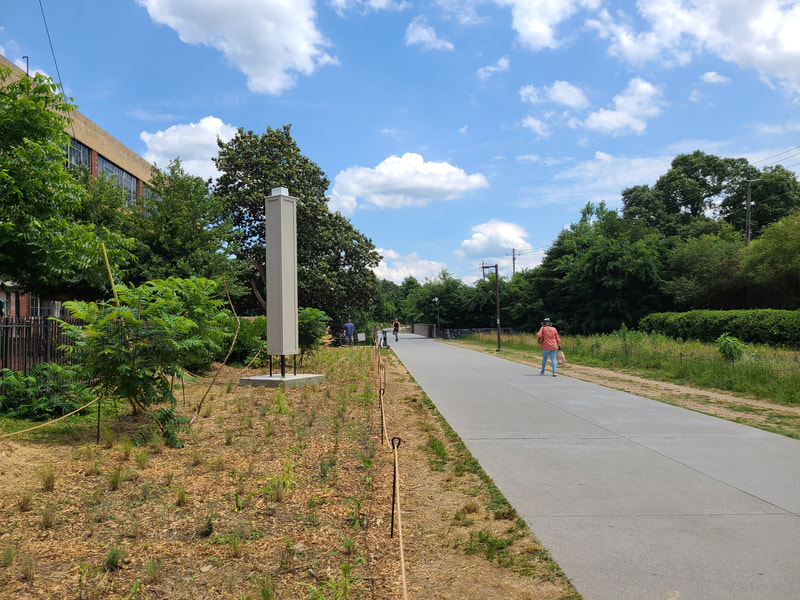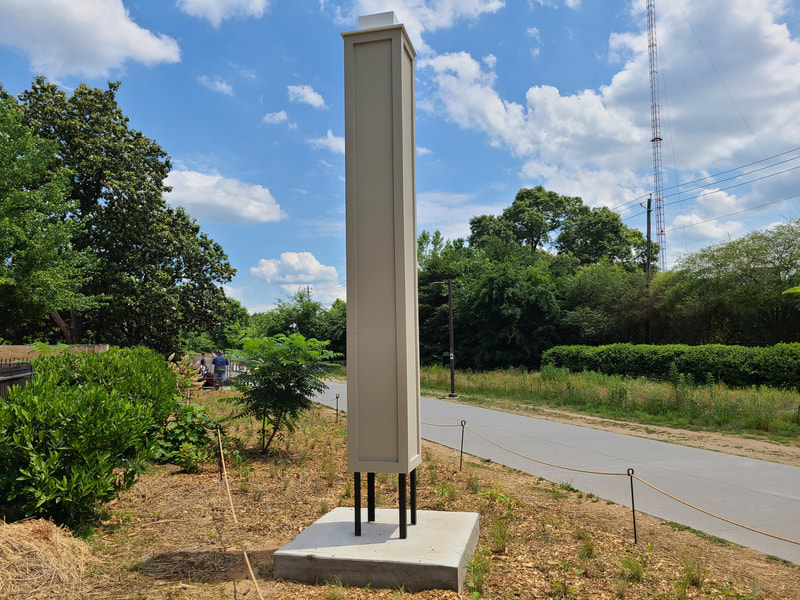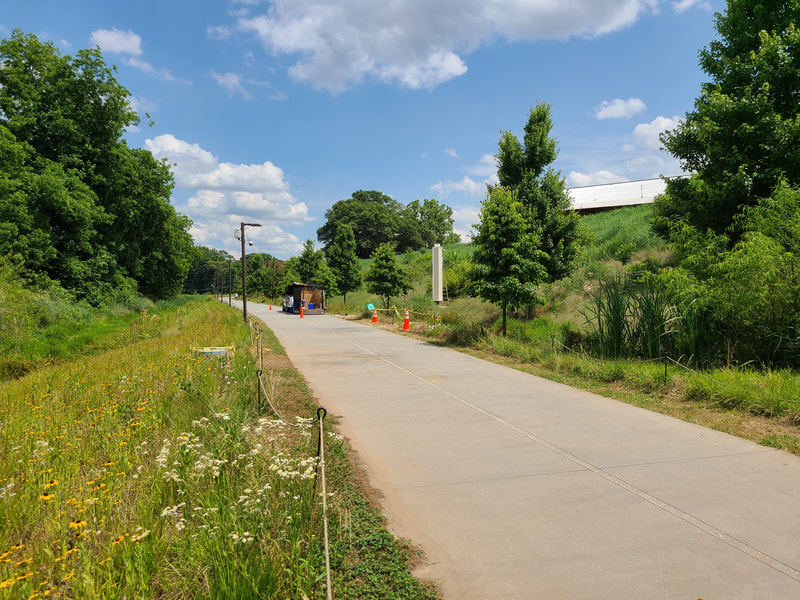|
Photos 1 and 2 are of the Eastside Tower and photo 3 is of the Westside Tower. Photos by Adam Betuel. by Dottie Head, Director of Communications
Georgia Audubon and the Atlanta BeltLine recently partnered on a project to install two 12-foot-tall Chimney Swift towers along the Atlanta BeltLine. Funded by a generous grant from Patagonia Atlanta, one tower is located on the Atlanta BeltLine Eastside Trail and the second tower is on the Atlanta BeltLine Westside Trail. Designed to mimic actual chimneys, these towers will serve as roosting and nesting habitat for Chimney Swifts. In addition, a bird-friendly native plant garden has been installed at the Eastside Trail project site thanks to generous grants from the Georgia Ornithological Society and the Cherokee Garden Club with additional funds from Georgia Audubon. Still a fairly common sight in the metro area, Chimney Swifts are being forced to respond to additional threats across their range—from chimney capping, to tree removal, to a decreasing supply of insects due to pesticides and climate change. Other issues, such as building collisions and challenges on swifts’ wintering grounds are exacerbating population declines. These are the seventh and eighth towers Georgia Audubon has constructed in recent years. “The Chimney Swift is one of Georgia Audubon’s focal species, and we have been working with various organizations across the metro area to create habitat for this aerial insectivore,” says Adam Betuel, director of conservation for Georgia Audubon. “We were delighted to partner with the Atlanta Beltline with funding from Patagonia Atlanta to build these towers, which we hope will not only provide nesting and roosting habitat for swifts, but will also educate the millions of people who walk along the Atlanta BeltLine about the importance of supporting these birds. We’re also excited to install a native plant garden near the Eastside tower to attract birds, bees, and other pollinators and show people how easy it is to incorporate native plants into their landscapes.” Chimney Swifts have specially adapted feet that allow them to cling to the inside of hollow structures, like these towers. The swifts build saucer-shaped nests made out of twigs glued together with the birds' saliva. Chimney Swifts rarely allow other birds (including other swifts) to use "their" tower while they are nesting, but in late summer, hundreds or even thousands of individual birds may roost in one large chimney, creating a spectacular site overhead as they flock into the chimney near dusk. In exchange for the roosting site, Chimney Swifts will provide natural pest control as each swift may consume up to 1,000 flying insects, including mosquitos, each day. “The Atlanta Beltline Initiative is very excited to collaborate with Georgia Audubon on the installation of these two Chimney Swift Towers that will support the migration of these wonderful birds,” says Kevin Burke, FASLA and principal landscape architect for the Atlanta BeltLine. “We look forward to future opportunities to further enable and enhance our 22-mile pollinator and wildlife corridor.” Since the 1950s, Chimney Swifts and other aerial insectivores have experienced drastic population declines due to several factors, such as the increased use of pesticides that harms their main prey, flying insects, and the loss of swifts’ nesting and roosting habitat (formerly hollow trees and more recently, man- made chimneys). Chimney Swifts, now listed as Vulnerable by the IUCN Red List of Threatened Species, have responded to these challenges by increasingly flocking to urban areas that offer abandoned factory smokestacks or historical home chimneys that have been left uncapped and which mimic their natural breeding and roosting sites. GPS Coordinates for the two towers: Atlanta BeltLine Eastside tower - 33.768029081412074, -84.36123996414393 - in front of Telephone Factory Lofts Atlanta BeltLine Westside tower - 33.727446999583876, -84.41617312817229 - Not far from the Lee & White development About Georgia Audubon: Georgia Audubon is building places where birds and people thrive. We create bird-friendly communities through conservation, education, and community engagement. About the Atlanta BeltLine: As one of the largest, most wide-ranging urban redevelopment programs in the United States, the Atlanta BeltLine is the catalyst for making Atlanta a global beacon for equitable, inclusive, and sustainable city life.
6 Comments
chuck Rushing
6/2/2021 08:52:31 pm
can you post or email me the construction plans for your towers - would like to build one or two
Reply
6/3/2021 02:13:21 pm
We aren't able to share our plans, but Adam, our director of conservation recommends this book which has a few layouts
Reply
Allen Moye
6/16/2021 10:41:41 am
What does it cost Georgia Audubon to build these towers?
Reply
Georgia Audubon
6/16/2021 10:45:10 am
Please reach out to Adam Betuel, our director of conservation, at adam.betuel@georgiaaudubon.org for more information.
Reply
Michael Turner
6/23/2021 05:00:38 pm
I wanted to get more information about the chimney swifts house designs, desired placment, suggested bird friendly plants for the area, and costs, etc.,
Reply
Your comment will be posted after it is approved.
Leave a Reply. |
AuthorBirds Georgia is building places where birds and people thrive. Archives
April 2024
Categories |




 RSS Feed
RSS Feed

